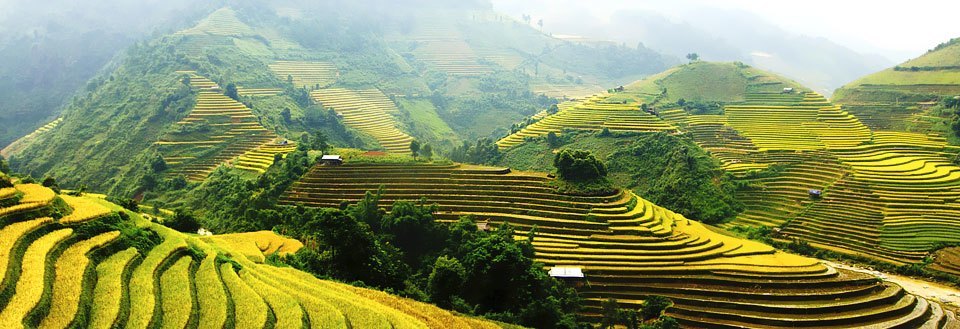Vietnam is moving beyond the shadow of the war and has opened up its borders, so today tourists can enjoy the beautiful natural scenery of the countryside and the famous hospitality of the inhabitants.�
Viet Nam (Cung Hoa Xa Hoi Chu Nghi Viet Nam)
Hanoi
325,360 km2
Vietnamese
No official religion. Communism. Buddhism�
78,773,873 (June 2000)
Socialistic republic
Vietnam borders on China, Laos and Cambodia. To the east and west, the country is bordered by the Chinese Sea. Vietnam is shaped like an S, and the distance from north to south is more than 1600km. The Metong River and the Red River flow through the country, and are the basis of the country's production of rice. Furthermore, a large part of the country is covered by mountains and jungle.
In Vietnam, there is no real peak- or off-season. The climate varies from region to region, and when it is cold and wet in one region it is hot and sunny in another region.
Lonely Planet Vietnam
Rough Guide Vietnam
Fodor's Vietnam
�
Vietnamese dong (VND)
If you visit the large cities in Vietnam, it is no problem to find Internet cafés. Especially Hanoi and Ho Chi Min City have many Internet cafés. In the country, you cannot count on access to the Internet.
To call for help, dial following numbers:
Police - 13
Fire Service - 14
Ambulance - 15
Tips are not expected but are appreciated.
When then time is 11.00 in Britain, it is 18.00 in Vietnam. In the summer, the time difference is only five hours, as Vietnam does not change to summertime.
Length: Metre
Weight: Kilo
Cubic content: Litre
Temperature: Celsius
It is allowed to photograph in most places in Vietnam. If you are in doubt then ask for permission. Airports and military installations cannot be photographed.
It is recommended that you do not drink the tap water, drink mineral water instead. Try to avoid ice cubes, as the hygiene is not always good.
220v/110v. The voltage differentiates.
Always make sure to dress nice and decently as the Vietnamese are very concerned with proper clothing. If you choose to follow the norms you can be sure to be treated with respect, and it can be easier to get what you want. People older than you must be treated with respect.
Banks are open from 07.00-17.00, lunch break from 11.30-14.00 (Monday-Friday). Banks are open in the morning on Saturdays.
It is difficult to determine the opening hours of shops. Usually, shops are open from early morning until late night.
Vietnamese food is varied and can be delicious. The country has approximately 500 traditional dishes, which consists of everything from cobras and shellfish to delicious vegetarian dishes. Fish is also an important ingredient in the Vietnamese kitchen, and practically all dishes are served with rice and noodles. Green tea is served everywhere. Vietnamese coffee is excellent, and beer is also served everywhere.
�
There are very few hotels or museums etc., which show any awareness of the needs of disabled travellers.�
New Year's Day, 1st January
Tet - New Years Celebration, in January or February and lasts for at least three days
The Liberation of Saigon, 30th April
Labour Day, 1st May
Ho Chi Min's Birthday, 19th May
National Day, 2nd September
No camping possibilities.
There are no B&B/guesthouses.
There are no hostels.
Vietnam has very good domestic airline connections. It is relatively expensive to fly domestically as Vietnam Airlines has a monopoly. It is more expensive for tourists to fly to domestic destinations than it is for the Vietnamese.�
In Vietnam, the bus network is both good and cheap. Notice that buses are always crowded.
It is preferable to take the express trains instead of local trains, which are often crowded. There are two classes on the trains, and a "soft seat" is preferable. There are many thieves on the trains, therefore, make sure not to leave your luggage unattended.
There are taxi companies only in the large cities. However it is always possible to get a private driver. Remember to always agree on a price in advance as the drivers do not have fare-meters.�
It is not possible to rent cars in Vietnam, and it is only legal to drive for persons with a Vietnamese license.
In the chaotic traffic in Vietnam, bicycles as a means of transportation is recommendable. Bicycles are let at the hotels or in bicycle shops.
In the cities, scooters is also used a lot as a means of transportation. You can rent scooters at the hotels, and it is inexpensive. Always remember to wear a helmet; the Vietnamese drive like crazy.
Around in the country are still remnants from the war. For example there are areas in which mines have not yet been removed. Therefore it is recommended that you stay on paths and roads, unless you are travelling with someone acquainted with the local conditions. Mines are especially a problem in Central Vietnam.�
